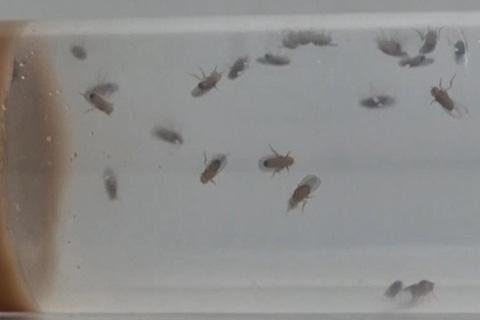Govind Kunduri, Ph.D., watched as a bright light illuminated a transparent tube full of mutant fruit flies. Then, as he prepared to collect data, something unexpected occurred: the flies began having seizures.
The flies’ surprising behavior seemed epileptic, but Kunduri, a postdoctoral fellow in the Cancer and Developmental Biology Laboratory (CDBL), part of the Center for Cancer Research at NCI at Frederick, hadn’t intended to study epilepsy. He was investigating how enzyme reactions were involved in the mutant flies’ processing of vision, including their reactions to light.
Nevertheless, Kunduri and his colleagues decided to investigate the seizures, eventually confirming that the phenomenon was, in fact, photosensitive epilepsy—seizures induced by visual stimuli, like light. Amazingly, it was the first recorded instance of photosensitive epilepsy in a laboratory animal.
“It took us a while before we were convinced,” recalled Jairaj Acharya, Ph.D., Kunduri’s supervisor and a senior investigator in the CDBL.
The fly model, a strain of Drosophila melanogaster, addresses a previously unmet need in the study of photosensitive epilepsy. Despite more than 150 years of research, scientists had no live, reliable model to study the disease in a laboratory—until now.
According to the paper published in the Proceedings of the National Academy of Sciences by Kunduri, Acharya, and their colleagues, many of the mutant flies do not survive to adulthood, but of those that do, 90 percent exhibit photosensitive epilepsy. The flies offer scientists a new way to study the disease, and the team believes that they also will be useful for understanding epilepsy in humans.
As part of this work, the team identified a relationship between sphingomyelin, a biomolecule in humans, and CPE, a biomolecule connected to the photosensitive epilepsy in the mutant flies. The two have similar functions and structures, suggesting that the flies’ biomolecules closely model the human ones.
The flies possess a mutation that makes it difficult to create functional CPE, which they need for several biological processes, including one—the formation of a protective membrane around neuronal cells—that would help prevent seizures. Instead, since the flies lack functional CPE, their nervous systems erratically process electrical signals when they are suddenly exposed to light.
Because of CPE’s similarity to sphingomyelin, the team believes that sphingomyelin deficiency may be involved in photosensitive epilepsy in humans. Their investigation offered encouraging support: a strain of CPE-deficient flies that was bred to possess sphingomyelin didn’t suffer from seizures when exposed to light, illustrating the connection between the two biomolecules.
“We can subject the mutant flies to drugs for the suppression of the [epilepsy] and ask if the findings can be extended to humans,” Acharya said.
The model is one of the latest examples of Drosophila melanogaster’s value in research. Fruit flies have long offered scientists a means to study genetics and have revealed much about gene regulation and various diseases, including cancer and—now—photosensitive epilepsy.
Going forward, the team plans to investigate other genes that may enhance or suppress the flies’ photosensitive epilepsy, which they hope will reveal more about the disease’s origins, behavior, and vulnerabilities.
Acharya says the team is gratified to have developed a tool that will help scientists in the future, even if it appears to be small. Since many important scientific discoveries occur incrementally, even a “small” tool can provide a foundation for larger advances.
Both Kunduri’s original investigation and the subsequent discovery of the flies’ epileptic behavior grew out of the CDBL’s ongoing research into enzymes of sphingolipid metabolism in several biological contexts, including cancer, vision, neurodegeneration, and aging. According to Acharya, it’s a challenging topic due to the technical complexity and an ever-growing field of research. However, the CDBL continues its studies, spurred on by its staff’s scientific interest and NCI at Frederick’s support, including the stability through which NCI allows scientists to investigate challenging concepts with the potential for long-term study and value.
“NCI has a unique environment that encourages scientific pursuit considered risky and difficult in other circumstances,” Acharya said.
Mutant fruit flies lacking CPE experience seizures when exposed to a flash of light in the lab.


